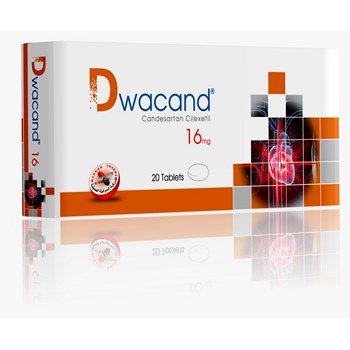Dwacand16
-Candesartan cilexetil is a prodrug suitable for oral use. It is rapidly converted to the
active drug, Candesartan, by ester hydrolysis during absorption from the
gastrointestinal tract. Candesartan is highly selective, long lasting and no
competitive antagonist specific for AT1 angiotensin II receptor with tight binding to
and slow dissociation from the receptor, consequently it inhibits angiotensin II
induced vasoconstrictor and aldosterone-secreting effects.
-The antagonism of the angiotensin II (AT1) receptors results in dose related
increases in plasma renin levels, angiotensin I and angiotensin II levels, and a
decrease in plasma aldosterone concentration.
-Candesartan does not inhibit ACE, which converts angiotensin I to angiotensin II
and degrades bradykinin. Candesartan does not affect ACE and gives no
potentiation of bradykinin or substance P. In controlled clinical trials comparing
candesartan with ACE inhibitors, the incidence of cough was lower in patients
receiving candesartan cilexetil.
-Candesartan does not bind to or block other hormone receptors or ion channels
known to be important in cardiovascular regulation.
-Candesartan causes a dose-dependent, long-lasting reduction in blood pressure. The
antihypertensive action is due to reduced peripheral resistance, while heart rate,
stroke volume and cardiac output are not affected. There is no evidence of serious or
exaggerated first dose hypotension or rebound effect after cessation of Candesartan treatment.
-Candesartan is effective in all grades of hypertension. Candesartan provides
effective and smooth blood pressure reduction over 24 hours.
-Dwacand® is similarly effective in patients regardless of age and gender.
-Dwacand® increases renal blood flow, and does not influence or increase
glomerular filtration rate while the renal vascular resistance and filtration fraction
are reduced.
-Candesartan has no adverse effects on blood glucose or lipid profile.
-The average absolute bioavailability of candesartan is approximately 35 %
following oral administration of Candesartan cilexetil.
-The mean peak serum concentration (Cmax) is reached 3 - 4 hours after the tablet
intake.
-The candesartan serum concentrations increase linearly with increasing doses in the
therapeutic dose range.
-Candesartan is highly bound to plasma protein (more than 99 %).
-The evident volume of distribution of candesartan is 0.13/kg.
-The terminal half-life of candesartan is approximately 9 hours. There is no
accumulation following multiple doses.
-Following an oral dose of radioactively labelled candesartan cilexetil, approximately 26 % of the dose is excreted in the urine as candesartan and 7 % as inactive metabolites while approximately 56 % of the dose is recovered in the faeces as candesartan and 10 % as inactive metabolites


